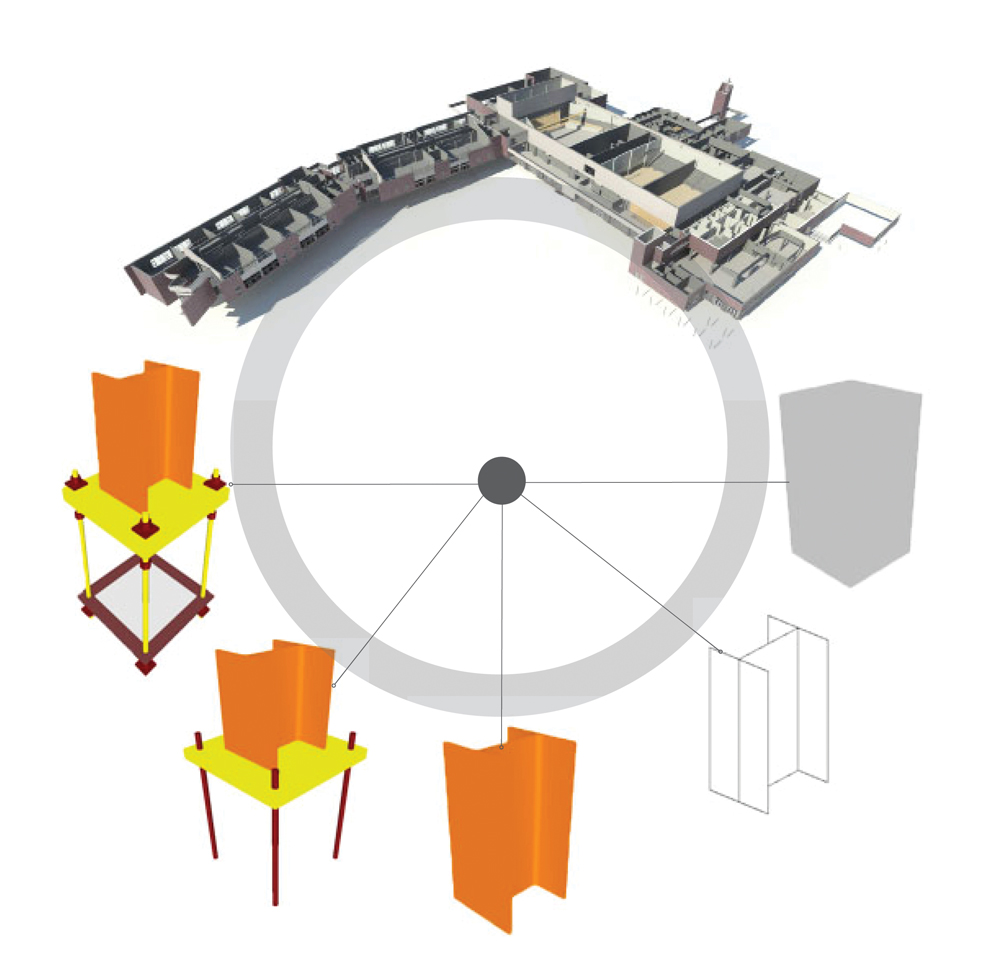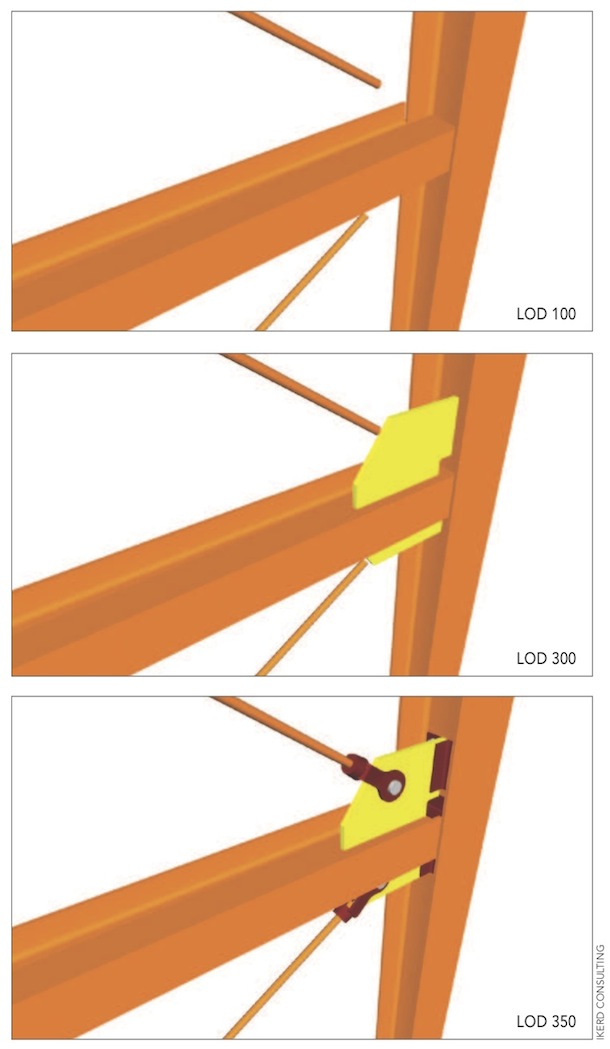In 2008, the American Institute of Architects released its first BIM contract document—AIA E202 Building Information Modeling Protocol Exhibit—which outlined five “levels of development” (LOD 100-500) for defining the amount of detail in a particular BIM model. E202 provided basic definitions of each LOD but left a lot open to interpretation.
“The E202 was a huge first step in that it provided the first viable vehicle for defining a BIM model at the element level and enabling downstream users to rely on it,” says James Bedrick, FAIA, LEED AP, Founder and Principal of AEC Process Engineering (www.aecpe.com). “Practitioners found, though, that the LOD definitions were being interpreted differently, and that there was a need for more clarity. What does LOD 200 specifically mean, for example, for a door?”
None of the LODs offered a graphical representation of what a model at that level would look like or detailed instructions for how to use models in each LOD for a variety of disciplines. The document, which the AIA has since updated and published as the AIA G202-2013 Project Building Information Modeling Protocol Form (June 2013), had no specific rules or requirements for exactly what’s in a model at each level. As a result, design firms, general contractors, and subcontractors have no idea exactly what they would be handing off or receiving by way of the BIM model.
Level of Development Specification Definitions
• LOD 100 — The model element may be graphically represented in the model with a symbol or other generic representation, but does not satisfy the requirements for LOD 200. Information related to the model element (i.e., cost/sf, tonnage of HVAC, etc.) can be derived from other model elements.• LOD 200 — The model element is graphically represented within the model as a generic system, object, or assembly with approximate quantities, size, shape, location, and orientation. Nongraphic information may also be attached to the model element.
• LOD 300 — The model element is graphically represented within the model as a specific system, object, or assembly in terms of quantity, size, shape, location, and orientation. Non-graphic information may also be attached to the model element.
• LOD 350 — The model element is graphically represented within the model as a specific system, object, or assembly in terms of quantity, size, shape, orientation, and interfaces with other building systems. Nongraphic information may also be attached to the model element.
• LOD 400 — The model element is graphically represented within the model as a specific system, object, or assembly in terms of size, shape, location, quantity, and orientation with detailing, fabrication, assembly, and installation information. Nongraphic information may also be attached to the model element.
• LOD 500 — The model element is a field-verified representation in terms of size, shape, location, quantity, and orientation. Nongraphic information may also be attached to the model element.
Source: BIMForum and American Institute of Architects
A new standard promises to lend much-needed clarity to the BIM model detail issue. BIMForum, a multidisciplinary group of BIM users, has released its first BIM deliverable document, the Level of Development Specification. Working under an agreement with the AIA, the BIMForum LOD committee added context and meaning to the AIA G202-2013 definitions for levels 100, 200, 300, and 400, and added a new level (350) for trade coordination. It enables Building Teams to specify and articulate with a high level of clarity the content and reliability of BIM models at various stages, allowing downstream users to clearly understand the usability and limitations of models they are receiving. It’s organized by CSI Uniformat 2010, but expands the subclasses to Level 4 to provide a detailed breakdown and more clarity to the element definitions.
“The key to being able to break out of this quasi-definition cycle is collaboration,” says James Vandezande, AIA, Principal at HOK (www.hok.com), who served on BIMForum’s LOD committee. “It’s a stepping stone to get from document deliverables to model deliverables. This particular stepping stone is the tool that levels expectations between different stakeholders and provides an apples-to-apples comparison.”
“The LOD Specification is not prescribing a particular progression or approach for creating models,” says Jan Reinhardt, Principal at Adept Project Delivery (www.adeptprojectdelivery.com) and Co-chair of the LOD committee. “It only provides clear language for communicating, describing, and agreeing on a progression and quality of a model that is specific for a particular project.”
Built by a Building Team
The LOD committee was set up on a multidisciplinary basis, with Reinhardt (a GC) and Bedrick (an architect) overseeing committee members organized in several domain-specific groups (e.g., structural, interior construction, exterior skin). Each group had one construction professional and one designer to represent their respective points of view during the development process.
LOD 500: The coming O+M BIM model
Early on in the process of deciding what to include in the first Level of Development Specification, the BIMForum LOD committee concluded that level 500 would have to be put on hold. AIA E202 defines LOD 500 this way: “Model elements are modeled as constructed assemblies, actual and accurate in terms of size, shape, location, quantity, and orientation. Non-geometric information may also be attached to modeled elements.”As the industry struggles with the concept of using BIM models for facilities management (FM) tasks, this definition could be construed to be an operations and maintenance level, or as a model for as-built conditions.
“For the first phase of the rollout, we decided to concentrate on levels 100-400 as a starting point,” says Jan Reinhardt, Principal at Adept Project Delivery and Co-chair of the LOD committee. Reinhardt says the committee felt that many common FM-related tasks could be accomplished by using lower-level BIM models, especially when it comes to document management.
A growing number of building owners are demanding BIM models that can be used for FM purposes, but there is little consensus on how to achieve this goal. At a BIMForum meeting last winter in Tacoma, Wash., some of the concerns addressed were: Whose responsibility is it to input all model information into a system to hand off to facilities managers? What system is to be used if not specified by the owner? What would be the best system to recommend to an owner? Is highly detailed information such as structural tolerances of each beam really necessary for FM? Is it one system that catalogs all products in the entire building, or several different systems for different parts of the building?
“Level 500 is really about pure information, not graphical representations,” says David Francis, BIM Division Leader at Southland Industries (www.southlandind.com) and a member of BIMForum’s LOD committee. “The problem is there are software people trying to tell FM people how to run their business. If you’re an FM person, you’ll be using your FM or BMS software interface, but pulling the information from the BIM model and documents associated with the model. An FM guy is not going to open a Navisworks model and fly through it to find out what’s wrong with his building. He just wants the information.”
“One of the things we all agreed to was that level 500 needed to be the field-verification aspect of the data accompanying the model geometry,” explains Ron Dellaria, Chief Compliance Officer at Astorino and a member of the LOD committee. “We asked, ‘If it really is the as-built model, does it necessarily need that level of granularity for FM?’ You can’t equate an as-built model to an FM model. Not yet, at least. This will take more research. We felt it was best to tackle it in a later version.”
“The benefit of this setup was that, as we were developing the LODs, we were passing them off to each other,” says Ron Dellaria, Chief Compliance Officer at Astorino (www.astorino.com), who served on the LOD committee’s interior construction group. “It was of utmost importance to get a view of what the end user, in this case the contractor, wanted to see in terms of data. We could preserve design intent and they could tell us what they needed. If this really is the new deliverable, what we’re issuing needs to be acceptable by those using it next.”
What quickly became apparent to the committee was that different disciplines would need to continue to work at different levels of modeling as projects progressed. For example, structural engineering would always be ahead of MEP engineering.
“No two buildings are alike and no two workflows of element development will be the same,” says Will Ikerd, Principal at Ikerd Consulting (www.ikerd.com), who served on the LOD committee’s structural group. “There will be similarities, just like every building has a foundation, but how that comes together will differ, as well as how the LOD in each discipline comes together at different times in the project.
Ikerd, a BD+C “40 Under 40” honoree (class of 2011), also saw a need for sequential LOD graphics for the specification document, providing a set of common images that define the model elements. “Until now, the AECO industry has been using thousands of words for LOD with no common images,” he says.
The LOD Specification document was published on July 3. The document has a high level of instruction and detail for all of its elements, and software manufacturers will have enough information to give proper detail for specification for 3D elements created in-house and by third-party software vendors just from reading the LOD definitions.
For more, visit: http://bimforum.org/lod.
As part of its work on the LOD Specification, the BIMForum LOD committee created sequential graphics for each level of development definition. The examples above depict a connection detail modeled at LOD 100 (top), 300 (middle), and 350 (bottom).
Related Stories
| Oct 25, 2011
Universal teams up with Earthbound Corp. to provide streamlined commercial framing solutions
The primary market for the Intact Structural Frame is light commercial buildings that are typically designed with concrete masonry walls, steel joists and steel decks.
| Oct 25, 2011
Ritner Steel CEO elected to AISC Board
Freund will begin serving on the AISC board of directors, assisting with the organization's planning and leadership in the steel construction industry.
| Oct 25, 2011
Commitment to green building practices pays off
The study, conducted by the Pacific Northwest National Laboratory, built on a good indication of the potential for increased productivity and performance pilot research completed two years ago, with similarly impressive results.
| Oct 25, 2011
DOE issues report on financing solar photovoltaic systems for K-12 schools
The report examines the two primary types of ownership models used to obtain solar installations. This analysis can help school administrators across the country select the best option for deploying solar technologies in their school districts.
| Oct 25, 2011
MKK participates in BSA Engineering Merit Badge day
MKK principal Craig Watts attended the event as a representative of the MEP (mechanical/electrical/plumbing) engineering industry to give scouts an idea of what’s involved in becoming a mechanical engineer, and an overview of a typical day in the life of an engineer.
| Oct 24, 2011
FMI releases Adjust, Adapt, Act Study
The paper explores several case studies, including Sun Country Builders, Huen, BakerTriangle, Consigli, Skender Construction and Flatiron, and distills the key factors that make these companies unique and successful.
| Oct 24, 2011
BBS Architects & Engineers receives 2011 Sustainable Design Award from AIA Long Island Chapter
AIA LI also recognized BBS with the 2011 ARCHI Award Commendation for the St. Charles Resurrection Cemetery St. Charles Resurrection Cemetery Welcoming and Information Center in Farmingdale, NY.
| Oct 24, 2011
Kolbe adds 3-D models of direct set windows to BIM library?
Beveled Direct Set SketchUp and Revit Models available.
| Oct 20, 2011
UNT receives nation’s first LEED Platinum designation for collegiate stadium
Apogee Stadium will achieve another first in December with the completion of three wind turbines that will feed the electrical grid that powers the stadium.

















